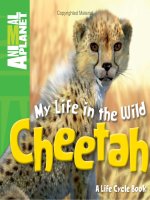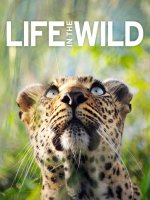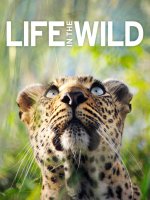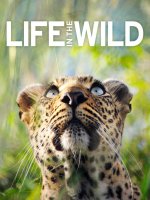life in the wild a
Bạn đang xem bản rút gọn của tài liệu. Xem và tải ngay bản đầy đủ của tài liệu tại đây (33.87 MB, 120 trang )
From the exquisite fragility of a butterfl y to the might and majesty
of a humpback whale, explore the extraordinary diversity of life in
this lavishly illustrated celebration of the animal kingdom. Packed
with awe-inspiring images taken by some of the world’s top wildlife
photographers, here are hundreds of fascinating species in their
natural environments.
Discover more at
www.dk.com
An Incredible Photographic
Portrait of the Animal World
000-001_Wild_Prelims_bear.indd 1 13/5/09 16:51:48US_000-001_Wild_Prelims_bear.indd 1 15/5/09 11:57:20
002-003_Wild_Prelims.indd 2 13/5/09 13:54:11US_002-003_Wild_Prelims.indd 2 15/5/09 16:00:05
002-003_Wild_Prelims.indd 3 13/5/09 13:54:27
l i f e i n t h e w i l d
US_002-003_Wild_Prelims.indd 3 15/5/09 11:57:07
004-005_Wild_Contents.indd 4 13/5/09 16:53:03
PROJECT EDITOR Nicky Munro
SENIOR ART EDITOR Sharon Spencer
EDITOR Bob Bridle
MANAGING EDITOR Stephanie Farrow
MANAGING ART EDITOR Lee Griffiths
PRODUCTION EDITOR Joanna Byrne
PRINT PRODUCTION CONTROLLER Imogen Boase
US EDITOR Chuck Wills
Produced with assistance from
XAB DESIGN
39c Highbury New Park
London N5 2EN
First American Edition, 2009
Published in the United States by
DK Publishing
375 Hudson Street
New York, New York 10014
09 10 11 12 10 9 8 7 6 5 4 3 2 1
176202—October 2009
Copyright © 2009 Dorling Kindersley Limited
All rights reserved
Without limiting the rights under copyright reserved
above, no part of this publication may be reproduced,
stored in or introduced into a retrieval system, or
transmitted, in any form, or by any means (electronic,
mechanical, photocopying, recording, or otherwise),
without the prior written permission of both the
copyright owner and the above publisher of this book
Published in Great Britain by
Dorling Kindersley Limited.
A catalog record for this book is available from the
Library of Congress
ISBN: 978-0-7566-5696-6
DK books are available at special discounts when
purchased in bulk for sales promotions, premiums,
fund-raising, or educational use. For details, contact:
DK Publishing Special Markets, 375 Hudson Street,
New York, New York 10014 or
Printed and bound in Singapore by Star Standard
LONDON, NEW YORK, MELBOURNE,
MUNICH, AND DELHI
US_004-005_Wild_Contents.indd 4 1/6/09 12:49:55
004-005_Wild_Contents.indd 5 13/5/09 16:53:22
c o n t e n t s
006 introduction
008 mammals
078 birds
148 reptiles and amphibians
218 fish
288 invertebrates
358 index
360 acknowledgements
US_004-005_Wild_Contents.indd 5 15/5/09 11:57:00
006-007_WildIntro1.indd 6
13/5/09 14:00:05
Introduction Animal life is astonishing, intriguing, and
compellingly beautiful. Its sheer variety is staggering, from the sleek muscularity of a wild horse
to the mechanical articulation of a scuttling crab to the mesmerizing fluidity of a jellyfish. It can
inspire awe and sometimes even fear, but it is always fascinating. To watch a tiny insect hovering
at a flower as it sips nectar is to see a miniature miracle of natural engineering, and to witness
the deadly strike of a bird of prey is to marvel at the savage elegance of the hunter. Life in the
wild might be hard, but the ruthless logic of survival against the odds has driven the evolution
of animals that are all, in their diverse ways, honed to perfection.
Zoologists categorize animals into 37 groups called phyla. Of these, 36 are invertebrates, or
animals without backbones, such as insects, spiders, snails, and worms. Just one phylum
contains the vertebrates—the fish, amphibians, reptiles, birds, and mammals. Yet these are the
animals with which we are most familiar, partly because they are the biggest, but also because
they are our closest relatives. Birds alone inspire enthusiasm that can verge on the obsessive,
thanks to their exquisite plumage and fascinating behavior.
US_006-007_WildIntro1.indd 6 15/5/09 11:56:42
006-007_WildIntro1.indd 7 13/5/09 14:00:46
Such enthusiasm for wildlife can lead on to the kind of scientific study that has given us a deep
and hugely valuable understanding of the natural world. For some, however, this type of analysis
can get in the way of their instinctive appreciation of the sheer exuberance and beauty of nature.
Instead of hard facts, they want the frisson of excitement that is triggered by a close encounter
with a wild animal. For this, nothing can compare with physically being there—the almost tactile
experience of close, personal proximity—but we can get very close to it by seeing animals
through the eyes and lenses of some of the world’s finest wildlife photographers. We can feel
their passion, sense their excitement, and share their elation.
This book is a celebration of both animal diversity and the wildlife photographer’s art. The images
glow with color and depict every detail of texture, from the scales of a butterfly’s wing to the
cracks in the hide of a rhinoceros. They draw you into the animal’s world in a way that no
description, explanation, or diagram can. You can almost smell the hot breath of the African
buffalo, and hear the croak of the calling tree frog. This is nature in the raw, uncluttered by
interpretation or zoological detail. It is a wildlife experience in itself.
07
I N TR ODU C TI ON
US_006-007_WildIntro1.indd 7 1/6/09 12:49:41
008-009_mammals_opener1.indd 8 13/5/09 16:56:10US_008-009_mammals_opener1.indd 8 15/5/09 11:56:34
008-009_mammals_opener1.indd 9 13/5/09 16:56:47
m a m m a l s
US_008-009_mammals_opener1.indd 9 15/5/09 11:56:35
010-011_mammals_intro2.indd 10 13/5/09 17:02:16
Ask a child to describe an animal, and he or she will
nearly always think of a creature with four legs, fur,
and a whiskery face—a mammal. Such a definition
is hardly scientific, but everyone recognizes it. We
know the difference between a mammal and any
other type of animal without being told that all
mammals are warm-blooded, air-breathing
vertebrates that feed their young on milk. Some
mammals are certainly a little harder to identify.
A dolphin is very like a shark, which is a fish, and
in the past most people assumed that dolphins
were indeed fish. But most mammals—even spiny
hedgehogs, winged bats, and armor-plated
armadillos—are immediately recognizable as such.
This is probably because we are mammals
too. Our forelegs may have become arms, we
may have lost most of our fur, and we may like
to think we are more intelligent, but we are
still part of the family—or technically the order
Mammalia. Indeed we share 96 percent of our
DNA with chimpanzees. Other mammals are
our close relatives, so we relate to them.
One consequence of this is that we tend to think
of mammals as more important than other
animals. In reality, the 4,680 species of mammal
account for less than 10 percent of vertebrate
species, and a tiny fraction—0.25 percent—of
all known animal species. Yet while the mammals
are small in numbers, they often loom large in
the landscape. The African savannas teem with
tiny insects, but the animals that we notice are
the grazing herds of antelopes, gazelles, and
zebras, and the prowling lions and hyenas that
prey upon them. The largest of all land animals,
the African elephant, is a mammal, and so is the
blue whale—the largest animal that has ever
lived. Such giants have appetites to match, and
not simply because of their size. Mammals are
warm-blooded creatures that use a colossal
80 percent of their energy intake simply to
maintain their body temperature. A lion must eat
at least five times as much food as a cold-blooded
crocodile of equal size, and this explains why big
predatory mammals are relatively rare: there is
010
US_010-011_mammals_intro2.indd 10 15/5/09 11:56:22
010-011_mammals_intro2.indd 11 13/5/09 17:03:45
not enough prey available to support more.
Small mammals have even more extreme
energy requirements—a shrew must eat almost
constantly to make up for the energy it loses,
and if it is deprived of food for much more than
an hour it will die of starvation.
The advantage of this apparently wasteful
arrangement is that by regulating their own body
temperature, mammals are able to live all over the
planet, in all climates. Indeed a single mammal
species, the gray wolf, once lived almost worldwide
from the Arctic to the Arabian desert. This
flexibility has enabled mammals to exploit almost
every habitat on Earth. While Weddell seals hunt
beneath the sea ice off Antarctica, monkeys
clamber through the tropical rain forest canopy,
and desert foxes pursue gerbils over the sands
of the Sahara. The demands of different habitats
have brought about spectacular evolutionary
adaptations, such as the giraffe’s neck and the
huge eyes of the nocturnal tarsier. The result is
a wonderful variety of species. Some, such as
the giant anteater, are specialized for particular
habitats and diets. Others, such as the gray wolf,
are adaptable enough to live almost anywhere, much
like the most adaptable mammals of all—humans.
m a m m a l s
Adaptable, intelligent, and able to thrive
in almost any habitat, mammals are one of
the greatest success stories of evolution.
M A MM ALS
011
US_010-011_mammals_intro2.indd 11 15/5/09 11:56:24
012-013_mammals_koala.indd 12 29/4/09 12:51:54
US_012-013_mammals_koala.indd 12 15/5/09 11:56:08
012-013_mammals_koala.indd 13 29/4/09 12:52:00
$
Australia’s koala (Phascolarctos
cinereus) spends most of its
time—up to 20 hours a day—
snoozing in eucalyptus trees,
gripping onto the branches with its
long sharp claws. The koala is more
active at night, when an adult will
consume around 17
1
⁄2 oz (500 g)
of eucalyptus leaves. It has a very
highly developed sense of smell,
which helps it to differentiate
between poisonous and non-
poisonous leaves.
013
m a mm als
US_012-013_mammals_koala.indd 13 15/5/09 11:56:09
012-013_mammals_koala.indd 13 29/4/09 12:52:00
014-015_mammals_kangaroo.indd 14 29/4/09 11:35:44
014
%
The eastern gray kangaroo
(Macropus giganteus) lives in
parts of Australia and Tasmania,
in small social groups known as
“mobs.” Typically, these include
a leading male and several
subordinate males, along with two
or three females with young, known
as “joeys.” A newborn joey—no
bigger than a peanut—clambers
through its mother’s fur to her
pouch, locates a nipple, and
remains there, safely ensconced,
for up to a year before venturing
out into the wider world.
m a mm als
US_014-015_mammals_kangaroo.indd 14 15/5/09 11:55:59
014-015_mammals_kangaroo.indd 15 29/4/09 11:35:51US_014-015_mammals_kangaroo.indd 15 15/5/09 11:56:00
016-017_mammals_hedgehog.indd 16 29/4/09 12:53:58
US_016-017_mammals_hedgehog.indd 16 15/5/09 11:55:50
016-017_mammals_hedgehog.indd 17 29/4/09 12:54:03
$
The west European hedgehog
(Erinaceus europaeus) has poor
eyesight, but compensates for this
with a very well-developed sense
of smell, which helps it to find
slugs, worms, and beetles to eat,
and to detect potential threats. A
hedgehog’s defensive mechanism
is one of the best there is. It can
roll itself up into a spiny ball, and,
if necessary, it will remain like this
for hours, providing a very effective
deterrent against most predators.
017
m a mm als
US_016-017_mammals_hedgehog.indd 17 15/5/09 11:55:51
016-017_mammals_hedgehog.indd 17 29/4/09 12:54:03
018-019_mammals_bat.indd 18 29/4/09 12:53:33
018
%
Vampires are not just the
stuff of legends. The vampire
bat (Desmodus rotundus) lives
in Central and South America and
feeds on blood. Cows and horses
are typical victims, although
tapirs, large birds, and even
humans have been known to
provide the vampire with its
nightly 0.8 oz (25 ml) serving. A
hunting bat lands near its victim,
walks up to it and uses its heat-
detecting nose to find the right
place for the bite. The bat then
trims away any inconvenient fur
and uses its razor-sharp front
teeth to remove a piece of skin.
Usually the victim will feel
nothing. Anticoagulants in the
bat’s saliva keep the blood
flowing as the bat laps it up.
m a mm als
US_018-019_mammals_bat.indd 18 1/6/09 12:49:29
018-019_mammals_bat.indd 19 29/4/09 12:53:38
US_018-019_mammals_bat.indd 19 15/5/09 11:55:36
018-019_mammals_bat.indd 19 29/4/09 12:53:38
020-021_mammals_lemurs.indd 20 14/5/09 11:13:30
The lemur is endemic to Madagascar
and neighboring islands. Its thumbs
are opposable, like a human’s, and
its fingers and toes are tipped
with nails, rather than claws. This
strikingly marked lemur is Coquerel’s
sifaka (Propithecus coquereli).
US_020-021_mammals_lemurs.indd 20 15/5/09 11:55:23
020-021_mammals_lemurs.indd 21 7/5/09 11:39:30
This dangling black-and-white
ruffed lemur (Varecia variegata) is
holding onto a branch with its feet.
Lemurs use their tails to help them
balance when they jump from tree
to tree. At up to 10 lb (4.5 kg), this
is one of the largest of all lemurs.
US_020-021_mammals_lemurs.indd 21 15/5/09 11:55:24
022-023_mammals_tarsier.indd 22 12/5/09 15:38:30
022
%
The spectral tarsier (Tarsius
spectrum) is a tiny, nocturnal
primate found in tropical forests
in Sulawesi, Indonesia. Its fingers
and toes are tipped with special
pads to help keep it firmly in the
trees, though it frequently comes
down to earth to hunt. The
spectral tarsier is a ferocious
insectivore, taking prey more than
half its own size. It is just 4
1
⁄4–6 in
(11–15 cm) long, with an
additional 9
1
⁄2 in (24 cm) of tail,
and weighs just 3
1
⁄2–4
3
⁄4 oz
(approximately 94–132 g). The
spectral tarsier cannot move its
huge eyes, but can turn its head
to face forward or backward.
m a mm als
US_022-023_mammals_tarsier.indd 22 15/5/09 11:55:06
022-023_mammals_tarsier.indd 23 12/5/09 15:39:51US_022-023_mammals_tarsier.indd 23 15/5/09 11:55:07









